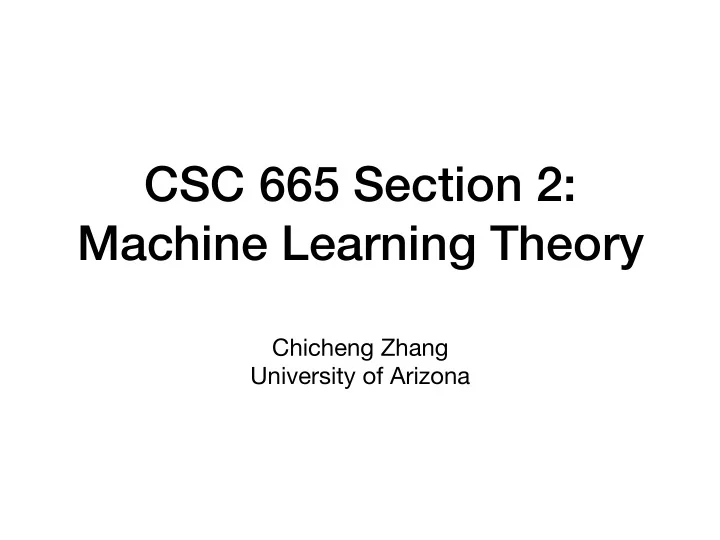

CSC 665 Section 2: Machine Learning Theory Chicheng Zhang University of Arizona
Logistics • Instructor: Chicheng Zhang (chichengz@cs.arizona.edu) • O ffi ce Hours: Mon 1-2pm, Gould-Simpson 720 • Website: https://zcc1307.github.io/csc665/
Machine learning (ML) • Algorithms build models that reflect patterns in the data, and use them for decision making • Examples: • Spam classification • Image recognition (face, handwriting) • Medical applications (diagnosis, treatment assignment) • Online advertising • Game playing • (the list grows continually..)
Settings of ML • Supervised learning • Unsupervised learning • Interactive learning
Supervised learning • Classification • Binary: image classification • Multiclass: text classification • Regression: • Weather forecasting (e.g. temperature / humidity) • Rich output: • Social media feed ranking
Unsupervised learning • Clustering • Topic modeling • Feature extraction • Image compression • Change-point detection • Trend detection in social media
Interactive learning • Online learning • Spam classification • News recommendation “Cat” • Active learning • Reinforcement learning • Imitation learning • …
What this course is about • A rigorous performance analysis on machine learning algorithms • Performance measure: • Sample complexity: #samples used • Computational complexity: time/space consumed • First half: statistical learning (mainly supervised learning) • Second half: online learning
Example: spam classification ● Email: Free Software! Offer lasts till 2/20 -- spam ● Email: CS Colloquium Lecture Series -- not spam ● Data: free offer lecture cs Spam? Email 1 1 1 0 0 +1 Email 2 0 0 1 1 -1 ● Prediction rule (Linear classifier): sign(9*free + 1*offer – 3.1*lecture) ● How many samples are needed to find a good linear classifier (say, with error < 0.01)?
Course preview • Part 1: statistical learning • The probably approximately correct (PAC) learning model • Practical algorithms motivated from theory - SVM, boosting • Analysis of (regularized) empirical risk minimization • Part 2: online learning • Online optimization, the regret model • Online-to-batch conversion • Online learning with partial feedback
Why learning theory? • Have guiding principles in mind when developing learning algorithms • e.g. regularization (early stopping, weight decay, adagrad) • Motivate new practical learning algorithms • e.g. boosting originates in a purely theoretical question • Understanding the success of practical method (and potentially resulting in better empirical approaches) • e.g. explaining the success of learning overparametrized neural nets
Prerequisites • (Multivariate) Calculus • Linear algebra • Probability • Basic programming • Additional background (helpful, not strictly required): • Numerical optimization, algorithm design and analysis • Calibration Homework (Due Sep 3 in class)
Evaluation • Homework (50%) • weekly assignments, 1-3 problems / assignment • Project (15%) • Midterm (15%): (tentatively Oct. 10) • Final (20%)
Project • Groups of 2-4 • Can be one of the following styles: • Literature survey (be critical!) • Implementation (do your experiments echo the theoretical results? If not, why?) • Research • Advances state-of-the-art on existing learning models • Study new learning paradigm • Project ideas will be up by mid-September
Project timelines • Proposal: Oct 24 • Progress report: Nov 14 • Final presentations: Dec 5 and Dec 10, in class • Final report (4 pages): Dec 11
Thank you! Questions?
Machine learning courses at UA • Fall 2019 • CSC 665 Section 1: Advanced Topics in Probabilistic Graphical Models by Jason Pacheco • Probabilistic modeling perspective • Spring 2020 • CSC 665: Topics in Online Learning and Bandits by Kwang-Sung Jun • Focuses on the online perspective • Other courses (see course website)
Recommend
More recommend